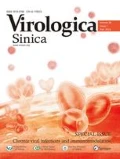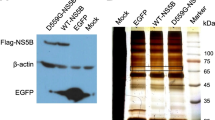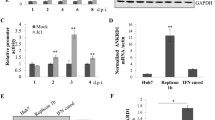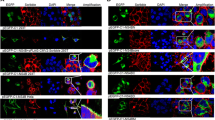Abstract
Hepatitis C virus (HCV) infects approximately 180 million people worldwide. Significant progress has been made since the establishment of in vitro HCV infection models in cells. However, the replication of HCV is complex and not completely understood. Here, we found that the expression of host prion protein (PrP) was induced in an HCV replication cell model. We then showed that increased PrP expression facilitated HCV genomic replication. Finally, we demonstrated that the KKRPK motif on the N-terminus of PrP bound nucleic acids and facilitated HCV genomic replication. Our results provided important insights into how viruses may harness cellular protein to achieve propagation.

Similar content being viewed by others
References
Alais S, Soto-Rifo R, Balter V, Gruffat H, Manet E, Schaeffer L, Darlix JL, Cimarelli A, Raposo G, Ohlmann T. 2012. Functional mechanisms of the cellular prion protein (prpc) associated anti-HIV-1 properties. Cell Mol Life Sci, 69: 1331–1352.
Benestad SL, Austbø L, Tranulis MA, Espenes A, Olsaker I. 2012. Healthy goats naturally devoid of prion protein. Vet Res, 43: 87.
Blight KJ, McKeating JA, Rice CM. 2002. Highly permissive cell lines for subgenomic and genomic hepatitis C virus RNA replication. J Virol, 76: 13001–13014.
Bounhar Y, Zhang Y, Goodyer CG, LeBlanc A. 2001. Prion protein protects human neurons against Bax-mediated apoptosis. J Biol Chem, 276: 39145–39149.
Brown DR, Qin K, Herms JW, Madlung A, Manson J, Strome R, Fraser PE, Kruck T, von Bohlen A, Schulz-Schaeffer W. 1997. The cellular prion protein binds copper in vivo. Nature, 390: 684–687.
Caruso P, Burla R, Piersanti S, Cherubini G, Remoli C, Martina Y, Saggio I. 2009. Prion expression is activated by adenovirus 5 infection and affects the adenoviral cycle in human cells. Virology, 385: 343–350.
Choo QL, Kuo G, Weiner AJ, Overby LR, Bradley DW, Houghton M. 1989. Isolation of a cDNA clone derived from a blood-borne non-A, non-B viral hepatitis genome. Science, 244: 359–362.
Collins JM, Raphael KL, Terry C, Cartwright EJ, Pillai A, Anania FA, Farley MM. 2015. Hepatitis B virus reactivation during successful treatment of hepatitis C virus with sofosbuvir and simeprevir. Clin Infect Dis, 61: 1304–1306.
Ende AR, Kim NH, Yeh MM, Harper J, Landis CS. 2015. Fulminant hepatitis B reactivation leading to liver transplantation in a patient with chronic hepatitis C treated with simeprevir and sofosbuvir: A case report. J Med Case Rep, 9: 164.
Friebe P, Boudet J, Simorre JP, Bartenschlager R. 2005. Kissingloop interaction in the 3' end of the hepatitis C virus genome essential for RNA replication. J Virol, 79: 380–392.
Gabus C, Auxilien S, Péchoux C, Dormont D, Swietnicki W, Morillas M, Surewicz W, Nandi P, Darlix JL. 2001a. The prion protein has DNA strand transfer properties similar to retroviral nucleocapsid protein. J Mol Biol, 307: 1011–1021.
Gabus C, Derrington E, Leblanc P, Chnaiderman J, Dormont D, Swietnicki W, Morillas M, Surewicz WK, Marc D, Nandi P. 2001b. The prion protein has RNA binding and chaperoning properties characteristic of nucleocapsid protein NCP7 of HIV-1. J Biol Chem, 276: 19301–19309.
Gao Z, Zhang H, Hu F, Yang L, Yang X, Zhu Y, Sy MS, Li C. 2016. Glycan-deficient PrP stimulates VEGFR2 signaling via glycosaminoglycan. Cell Signal, 28: 652–662.
Ikeda K, Kawada N, Wang YQ, Kadoya H, Nakatani K, Sato M, Kaneda K. 1998. Expression of cellular prion protein in activated hepatic stellate cells. Am J Pathol, 153: 1695–1700.
Koutsoudakis G, Herrmann E, Kallis S, Bartenschlager R, Pietschmann T. 2007. The level of CD81 cell surface expression is a key determinant for productive entry of hepatitis C virus into host cells. J Virol, 81: 588–598.
Kuwahara C, Takeuchi AM, Nishimura T, Haraguchi K, Kubosaki A, Matsumoto Y, Saeki K, Matsumoto Y, Yokoyama T, Itohara S. 1999. Prions prevent neuronal cell-line death. Nature, 400: 225–226.
Kwo P, Gane EJ, Peng C-Y, Pearlman B, Vierling JM, Serfaty L, Buti M, Shafran S, Stryszak P, Lin L. 2017. Effectiveness of elbasvir and grazoprevir combination, with or without ribavirin, for treatment-experienced patients with chronic hepatitis C infection. Gastroenterology, 152: 164–175.
Lötscher M, Recher M, Lang KS, Navarini A, Hunziker L, Santimaria R, Glatzel M, Schwarz P, Böni J, Zinkernagel RM. 2007. Induced prion protein controls immune-activated retroviruses in the mouse spleen. PLoS One, 2: e1158.
Lai CK, Jeng KS, Machida K, Lai MM. 2008. Association of hepatitis C virus replication complexes with microtubules and actin filaments is dependent on the interaction of NS3 and NS5A. J Virol, 82: 8838–8848.
Li C, Yu S, Nakamura F, Yin S, Xu J, Petrolla AA, Singh N, Tartakoff A, Abbott DW, Xin W, Sy MS. 2009. Binding of proprion to filamin a disrupts cytoskeleton and correlates with poor prognosis in pancreatic cancer. J Clin Invest, 119: 2725–2736.
Li Q, Zhang YY, Chiu S, Hu Z, Lan KH, Cha H, Sodroski C, Zhang F, Hsu CS, Thomas E, Liang TJ. 2014. Integrative functional genomics of hepatitis C virus infection identifies host dependencies in complete viral replication cycle. PLoS Pathog, 10: e1004163.
Liu T, Li R, Pan T, Liu D, Petersen RB, Wong B-S, Gambetti P, Sy MS. 2002. Intercellular transfer of the cellular prion protein. J Biol Chem, 277: 47671–47678.
Lohmann V, Körner F, Koch J-O, Herian U, Theilmann L, Bartenschlager R. 1999. Replication of subgenomic hepatitis C virus RNAs in a hepatoma cell line. Science, 285: 110–113.
Müller WE, Pfeifer K, Forrest J, Rytik PG, Eremin VF, Popov SA, Schröder HC. 1992. Accumulation of transcripts coding for prion protein in human astrocytes during infection with human immunodeficiency virus. Biochim Biophys Acta, 1139: 32–40.
Ma Y, Yates J, Liang Y, Lemon SM, Yi M. 2008. NS3 helicase domains involved in infectious intracellular hepatitis c virus particle assembly. J Virol, 82: 7624–7639.
Manns MP, Cornberg M. 2013. Sofosbuvir: The final nail in the coffin for hepatitis C?. The Lancet Infect Dis, 13: 378–379.
Mouillet-Richard S, Ermonval M, Chebassier C, Laplanche J, Lehmann S, Launay J, Kellermann O. 2000. Signal transduction through prion protein. Science, 289: 1925–1928.
Nakamura Y, Sakudo A, Saeki K, Kaneko T, Matsumoto Y, Toniolo A, Itohara S, Onodera T. 2003. Transfection of prion protein gene suppresses Coxsackievirus B3 replication in prion protein gene-deficient cells. J Gen Virol, 84: 3495–3502.
Nikles D, Bach P, Boller K, Merten CA, Montrasio F, Heppner FL, Aguzzi A, Cichutek K, Kalinke U, Buchholz CJ. 2005. Circumventing tolerance to the prion protein (PrP): Vaccination with PrP-displaying retrovirus particles induces humoral immune responses against the native form of cellular PrP. J Virol, 79: 4033–4042.
Odolini S, Lanza P, Angiola A, Zaltron S, Urbinati L, Vavassori A, Nasta P, Festa E, Gargiulo F, Rodella A. 2017. Hepatitis B virus reactivation after effective sofosbuvir and ribavirin treatment in a patient with occult hepatitis B virus infection. New Microbiol, 40: 218–220.
Paitel E, Fahraeus R, Checler F. 2003. Cellular prion protein sensitizes neurons to apoptotic stimuli through mdm2-regulated and p53-dependent caspase 3-like activation. J Biol Chem, 278: 10061–10066.
Prusiner SB, Groth D, Serban A, Koehler R, Foster D, Torchia M, Burton D, Yang S-L, DeArmond SJ. 1993. Ablation of the prion protein (PrP) gene in mice prevents scrapie and facilitates production of anti-PrP antibodies. Proc Natl Acad Sci U S A, 90: 10608–10612.
Richt JA, Kasinathan P, Hamir AN, Castilla J, Sathiyaseelan T, Vargas F, Sathiyaseelan J, Wu H, Matsushita H, Koster J. 2007. Production of cattle lacking prion protein. Nat Biotechnol, 25: 132–138.
Sailer A, Büeler H, Fischer M, Aguzzi A, Weissmann C. 1994. No propagation of prions in mice devoid of PrP. Cell, 77: 967–968.
Sakamoto N, Watanabe M. 2009. New therapeutic approaches to hepatitis C virus. J Gastroenterol, 44: 643.
Simister P, Schmitt M, Geitmann M, Wicht O, Danielson UH, Klein R, Bressanelli S, Lohmann V. 2009. Structural and functional analysis of hepatitis C virus strain JFH1 polymerase. J Virol, 83: 11926–11939.
Wakita T, Pietschmann T, Kato T, Date T, Miyamoto M, Zhao Z, Murthy K, Habermann A, Kräusslich H-G, Mizokami M. 2005. Production of infectious hepatitis C virus in tissue culture from a cloned viral genome. Nat Med, 11: 791–796.
Yamashita T, Kaneko S, Shirota Y, Qin W, Nomura T, Kobayashi K, Murakami S. 1998. RNA-dependent RNA polymerase activity of the soluble recombinant hepatitis C virus NS5B protein truncated at the c-terminal region. J Biol Chem, 273: 15479–15486.
Yang L, Zhang Y, Hu L, Zhu Y, Sy MS, Li C. 2014. A panel of monoclonal antibodies against the prion protein proves that there is no prion protein in human pancreatic ductal epithelial cells. Virol Sin, 29: 228–236.
Yang L, Gao Z, Hu L, Wu G, Yang X, Zhang L, Zhu Y, Wong BS, Xin W, Sy MS. 2016. Glycosylphosphatidylinositol anchor modification machinery deficiency is responsible for the formation of pro-prion protein (PrP) in Bxpc-3 protein and increases cancer cell motility. J Biol Chem, 291: 3905–3917.
Yang X, Zhang Y, Zhang L, He T, Zhang J, Li C. 2014. Prion protein and cancers. Acta Biochim Biophys Sin (Shanghai), 46: 431–440.
Zanusso G, Liu D, Ferrari S, Hegyi I, Yin X, Aguzzi A, Hornemann S, Liemann S, Glockshuber R, Manson JC. 1998. Prion protein expression in different species: Analysis with a panel of new mabs. Proc Natl Acad Sci U S A, 95: 8812–8816.
Zhong J, Gastaminza P, Cheng G, Kapadia S, Kato T, Burton DR, Wieland SF, Uprichard SL, Wakita T, Chisari FV. 2005. Robust hepatitis C virus infection in vitro. Proc Natl Acad Sci U S A, 102: 9294–9299.
Acknowledgments
This work was supported by the Strategic Priority Research Program A of the Chinese Academy of Sciences (XDA12010309), the National Science Foundation of China (31670170), the Nature Science Foundation of Hubei Province (2015CFA087), and the National Basic Research Priorities Program of China (2013CB911102). We thank the Core Facility and Technical Support, Wuhan Institute of Virology for assistance with confocal micros copy (Dr. Ding Gao) and flow cytometry (Ms. Juan Min).
Author information
Authors and Affiliations
Corresponding author
Electronic supplementary material
Rights and permissions
About this article
Cite this article
Zhang, H., Gao, S., Pei, R. et al. Hepatitis C virus-induced prion protein expression facilitates hepatitis C virus replication. Virol. Sin. 32, 503–510 (2017). https://doi.org/10.1007/s12250-017-4039-y
Received:
Accepted:
Published:
Issue Date:
DOI: https://doi.org/10.1007/s12250-017-4039-y




